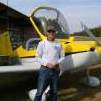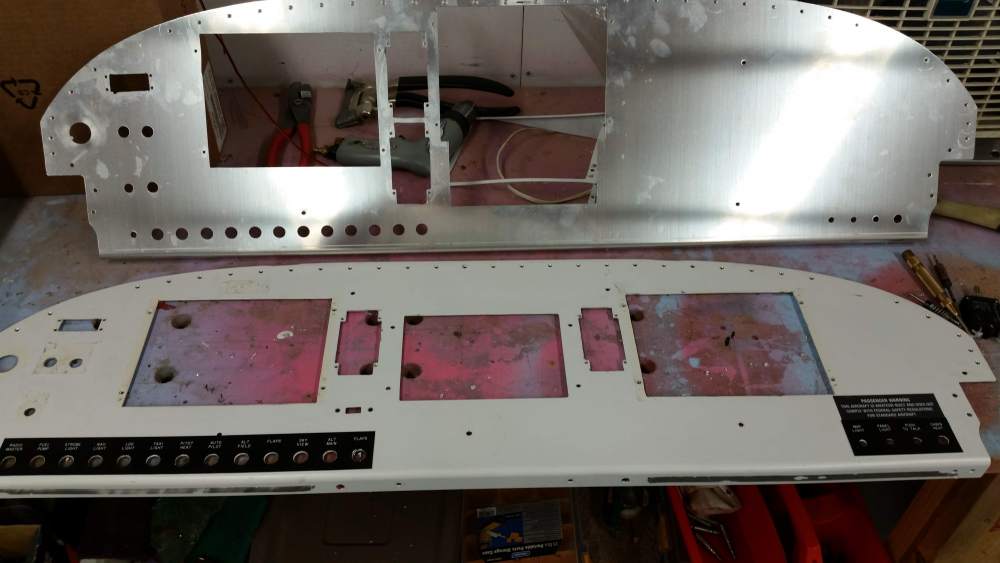-
Posts
1,169 -
Joined
-
Last visited
Content Type
Profiles
Forums
Blogs
Gallery
Downloads
Media Demo
Events
Everything posted by David Lloyd
-

Antenna mounted inside fiberglass belly panel
David Lloyd replied to David Lloyd's topic in Avionics/Panel Discussion
The electric gear or flaps causing enough activity for the Stormscope to display is not a big deal. What, 5 seconds for each, presumably with the runway right in front of the plane? If the alternator was loosing enough electrons to display on the scope, it would probably be causing other problems. A properly installed Stormscope or Strikefinder will not display anything in the airplane normally. I bought a WX-8 in 1984 and the range estimation was primitive. Large, active storms appeared closer. A very strong lightning discharge would light a number of segments at the same time, often in a row toward the airplane. Seeing that happen a number of times, you would learn what was happening. The clear button was your friend for helping understand how far away and how strong the storm activity was. Just like radar interpretation, it takes some learning and experience. Way back when, the Stormscope directions explained this pretty well. The basic instruction of don't fly into the dots or lighted segments worked pretty good back then. And today. -

40:1 landing gear question
David Lloyd replied to charlesual's topic in Vintage Mooneys (pre-J models)
"It’s not entirely worthless, it’s a deficient design when both the main system and back up system use the same gears in the actuator. There is no means of disconnecting a failed actuator from the retraction mechanism. " Still, it is a reliable system used not only by Mooney but by Beech on all Bonanzas and Barons. A part breaking and disabling both means of actuation on an otherwise working system is a 1% kind of problem. More realistic is bent actuation rods, frozen rod ends and improper downlock tensions due to lack of maintenance. The biggest problem will always be failure of the PIC to put the landing gear down. -
Was at MTV a few weeks ago. Beautiful airport, everything was green, mountains in the distance, the birds were singing. Pull up to the fuel pump and the airport manager is likely to come out and fuel your plane. The diner was open with outdoor seating. The runway had new painted lines and numbers. Bet the restroom was clean, didn't check.
-
The KX-155 and 165 radios are getting old and some components like capacitors are dying of old age. Once the capacitors leak, they can ruin a board. But the capacitors can be replaced by a few willing technicians. Bevan, Tulsa Avionics, and Sandhills Avionics are 3 that still will repair these older radios. If only the display replacement was available. I remember buying those for about $100. Not now! The spring replacement I mentioned above solved one problem, created another. After the repair, I noticed every once in a while the display would dim or even blink as I changed frequencies. Did that for a couple years until one day I turned the knob slowly to see if it really did cause the display to blink. Pow! Radio blew the internal fuse and needed a trip to another shop. Fuse replaced and said the reason for the blinking was an incorrect spring being used for the knob detent. A little fuzzy now, but it seems there were two sizes of springs, similar in appearance for the big knob and the little knob.
-
Gosh, the wind must have been really strong to blow a NWS employee into multiple street signs.
-
I recently replaced a drain valve in my 1975 M20C with bladder tanks. I think the number was F391-18. Looks very similar to the left valve in the first picture. I asked Griggs for the number before finding it listed on the drawing. While talking with him, I looked the number up on the Aircraft Spruce site. Asked about the O-ring and he said it used no O-ring like the picture at Spruce. Then I realized the -18 was the 1/8" NPT that seals on the threads, not by O-ring. Not much taper on the 1/8", I didn't even notice. In the end, check you part numbers every time.
-
3000' of cord? Not with the patterns I've seen people fly.
-

Antenna mounted inside fiberglass belly panel
David Lloyd replied to David Lloyd's topic in Avionics/Panel Discussion
Stormscope picks up the gear motor starting or stopping, or maybe switches making or breaking contact. Same thing with a Bonanza I had and the Stormscope worked great in that. -

Antenna mounted inside fiberglass belly panel
David Lloyd replied to David Lloyd's topic in Avionics/Panel Discussion
Thanks guys. Don't see this thing working properly under the fiberglass panel. It is a shame someone wasted money years ago mounting the antenna in such a location and never receiving any benefit from owning a Stormscope. Will get with a shop that knows what they are doing and get it moved. -
I have a one piece fiberglass belly panel installed. The Stormscope antenna has be mounted behind this panel since installed. Stormscope works, at least it lights when the gear moves up and down. I don't think I have seen it detect lightning...well, maybe once. Does anyone else have a Stormscope antenna mounted behind a fiberglass panel like this? Does it work? The install manual says it should be mounted with a 12" radius ground plane and the antenna never painted. It'll be a pain to move but I will if a couple people say what I have won't work.
-

Any Garmin 175 GPS pireps? Install time?
David Lloyd replied to Immelman's topic in Avionics/Panel Discussion
During installation your shop should have checked interference with other equipment, part of G's install checklist. Some do, some don't. Ask your radio shop if they have run into this problem. Example, yes read a couple posts down from where you quoted. -

wing drain valve part replacement
David Lloyd replied to Badmoonraising's topic in Vintage Mooneys (pre-J models)
So does Aircraft Spruce. Don't let the picture fool you, some have an o-ring to seal the threads, some are pipe thread. -

WTB STEC 55x Computer/Head Unit Only - 14v
David Lloyd replied to PhateX1337's topic in Avionics / Parts Classifieds
Genesys told me a couple weeks back that to do the the control head for my 60-2 would be around $650 (forgot the exact number) You have a different experience? -

Any Garmin 175 GPS pireps? Install time?
David Lloyd replied to Immelman's topic in Avionics/Panel Discussion
I did not have such a switch with annunciator installed. Expect $500-750. The problem I had with my 165 was one some frequencies (123.xx, 127.xx and 132.xx) when the mic was keyed the GPS would loose its signal lock. It would quickly lock back on but not comfort inspiring. Might have those frequencies wrong but you get the idea. The 155/165 were great radios but designed years before GPS was a consideration. -

Any Garmin 175 GPS pireps? Install time?
David Lloyd replied to Immelman's topic in Avionics/Panel Discussion
I recently had a 375 installed along with a PAR200B audio panel/com. It works fine with my Stec 60-2 with some limitations. Going over any waypoint may involve some zig zagging while recapturing the course. GPSS would eliminate that. Are you going to put in another switch to select between VOR/LOC and GPS? One possible hidden cost, older radios such as the KX155 and 165 may cause problems with the GPS. I was lucky in that a notch filter solved the problem. The radio shop said sometimes that works, sometimes not. They used the word lucky. I had old transponder, ADF, audio panel, GPS and 10 pounds of old wiring removed. Some panel work and moving stuff around, one old nav indicator was junk and replaced. Had an unforeseen problem with my HSI, and replaced that with a spare. So, a bunch of labor, about 75 hours. A fairly simple install with minimal rewiring, expect about 30 hours labor. -
If you can find appropriate drawings, having a pro cut your panel is great and usually not all that expensive in the scheme of things. Still, a lot of stuff can be cut with hand layout, drills, dremels, hand saws and files. Check the keystart hole on the left. All done by hand.
-
I'm equally suspicious of other indicators. The gauge you can continuously monitor and see that it is working. I would much rather have both a gauge and a light indicator. Naa. I would much prefer to get rid of the vacuum and go with all electric with a backup battery. Just waiting for approval from the home office. Just checked my POH to be sure. The 1975 C did not have a gauge, just an annunciator. Guess my gauge was added later. The 1976 models had a gauge but no annunciator. Glad mine has both.
-
If you vacuum pump fails you should catch the failure early on. That is the reason to include the vacuum gauge in your scan. if the pump has failed, cover up your vacuum powered instruments with a piece of paper or cardboard. It is near impossible to ignore a misbehaving instrument, a distraction you will not need even if VFR.
-
Don't cruise in that RPM range, that would be considered continuous. On an approach, use what you need and don't worry about it.
-
I had an old 7/8" very deep Craftsman socket for years. With the tight baffles on the RV (maybe Mooney too) it was long enough to be a problem getting past the baffle on the top plugs. One day I realized that it was so long, an inch could be cut off making it fit better. Measured carefully, worked perfect. A month later got some new Tempest plugs. My favorite socket would not reach the hex on the plug. Could not find a socket deep enough for the Tempest plugs. At Sun&Fun, the Tempest rep told me they still had a bunch of long sockets, send him an email. I did and got an appropriate socket the next week, free of charge. Had the Unison name imprinted, the plug mfgr. that Tempest bought. It does have wrench flats in addition to the ratchet drive.
-
Ask for a copy of the weight and balance. It is unlikely to be close to the 1050 useful load listed. Do you think the engine has made 1320SMOH without either cylinder work or turbo?
-

How long to fly Georgia to California?
David Lloyd replied to rbridges's topic in Miscellaneous Aviation Talk
No one else has said it. From west Texas on, afternoon turbulence is a near daily thing. Tends to suck the fun out of a long trip. -
Told the wifey that a man in Morganton had surprised everyone by putting his beautiful Mooney up for sale. Showed her a couple pictures and knowing the price, she said I should sell mine and buy Bob's plane. One of the best E's around. Matched Bob exactly.
-

How long to fly Georgia to California?
David Lloyd replied to rbridges's topic in Miscellaneous Aviation Talk
I flew my '65 C to Carlsbad, NM many times, about 2/3 of what you intend. Each time there was a fuel stop in Little Rock or Pine Bluff. Usually 9 hours flying, an hour break for fuel and a late breakfast. Later, there were a couple dozen trips in the Bonanza which cut the flying time to 8 hours. If you are really determined, San Diego could be a one day trip.




